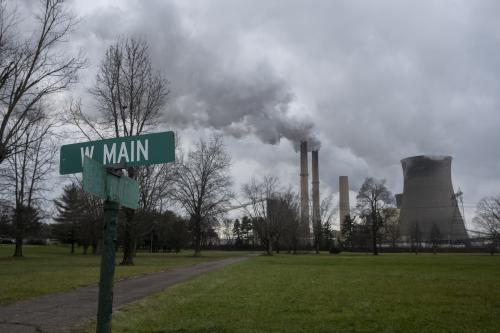The authors are grateful to Tegshbayar Darambazar (Legislation & Research Policy Hub) for providing substantive feedback on this post, and to all participants of our November 2020 roundtable, particularly to Erdenechimeg Dashdorj (Open Society Forum), Dorjdari Namkhaijantsan (Natural Resource Governance Institute), Batbayar Ochirbat (Transparency International Mongolia), and EITI Mongolia for sharing their expertise and insights, which is informing LTRC’s work in Mongolia. Уг блог нийтлэлийн Монгол орчуулгийг ЭНЭ холбоос дээр дарж үзнэ үү; a Mongolian translation of this blog post is available here.
In recent years, one battle in the fight against poor or corrupt natural resource governance has been the efforts to end anonymous corporate ownership.
Undisclosed ownership interests enable profound corruption in a variety of sectors, particularly in the extractive industries, where the magnitude of money involved attracts a number of insidious schemes. Consider the scenario where members of a legislature hold secret ownership stakes in mining companies, while at the same time drafting legislation governing that sector: They may prioritize self-interest over the well-being of the public—all without the public’s knowledge or ability to hold them to account.
To mitigate corruption risks, as well as a variety of other issues facilitated by secret corporate ownership, countries around the world have developed beneficial ownership (BO) registries—online databases that publish the names of company shareholders, owners, or beneficiaries.
At heart, the disclosure of BO pursues two objectives. First, it limits the ability of companies to use financial schemes or complex ownership structures to evade and avoid taxes, launder money, or finance illegal activities. Second, it inhibits a variety of corrupt interactions between private enterprise and public actors. For example, in a system with full transparency, a regulator would not be able to accept a bribe from a firm in exchange for a positive decision.
BO registries face a host of challenges. In Mongolia, where mining contributes around 23% of the country’s GDP, BO transparency (BOT) has made some progress, but profound issues remain.
Mongolia has been crafting its BO disclosure systems for the better part of this decade. In 2013, the Mongolia chapter of the Extractive Industries Transparency Initiative (EITI) took a first step when it requested voluntary disclosure of BO information from extractive companies. In 2016, the EITI Standard was expanded to require public disclosure of extractive company BO data. As a member of the EITI since 2006, Mongolia voluntarily committed to this provision, and the country devised a roadmap for meeting the criteria by the beginning of this year. However, it failed to meet the deadline.
Our approach
In late November 2020, the Leveraging Transparency to Reduce Corruption (LTRC) initiative, with the Open Society Forum, the Natural Resource Governance Institute, and Transparency International Mongolia, hosted a virtual roundtable on BO with stakeholders in Mongolia from civil society, government (regulatory bodies and Parliament), and international organizations. The event marked the beginning of LTRC’s work in Mongolia to strengthen the ongoing BOT process.
This work will be consistent with the LTRC TAP-Plus framework, which posits that bundled transparency, accountability, and participation (TAP) interventions can move the needle on corruption in natural resource governance when their design properly considers context and existing implementation gaps. LTRC aims to contribute to an ecosystem that makes BO disclosure more robust and leads to effective accountability.
For simplicity, we divided the discussion around BOT in four stages, as shown on the figure below: the legislative framework that governs it, the supply of data for the BO registry, and the demand for and use of the data that can be leveraged to foster accountability and oversight. We encouraged participants to discuss how to address challenges, including:
- Gaps in legislation and its enforcement
- Limitations to the usability and usefulness of the registry and existing data
- Lack of incentives and political economy constraints around the actual use of BO information
- Constraints to achieve effective accountability
Below, we outline key challenges and potential solutions that emerged from both the roundtable and LTRC’s research.
Legal framework
Mongolia’s BO legal and regulatory system offers at least three major areas for improvement. First, the system is vague and inconsistent, with legal disclosure requirements varying across statutes and ministries. Second, the threshold ownership levels that trigger a disclosure requirement are higher than international standards and potentially allow large numbers of owners to evade scrutiny. Third, the data that the government collects is inaccessible to the public.
At least seven different laws have a bearing on BO disclosure in Mongolia, from the Law on State Registration of Legal Entities to the Law on Minerals to the Law on Combating Money Laundering and Terrorist Financing. Unfortunately, the disclosure requirements are not harmonized across the laws and in some cases are overly vague, making them difficult to follow even for well-meaning companies.
The first step for a foreign or domestic enterprise operating in Mongolia is straightforward. It must register with the General Authority for State Registration. In a major improvement, as of January 2021, companies must disclose to the agency all ultimate beneficial owners that hold a 33% or more asset stake. Once registration is complete, companies are required to register with the General Tax Authority and then with a variety of other ministries, as appropriate. Unfortunately, the rules and requirements behind those later interactions do not always correspond with the general registry process. As a result, various regulators are unable to tie their records or efforts to another ministry’s records or data. The tangle of discordant rules and data is frustrating to companies that are trying to follow the rules. Worse, they also present opportunities for bad faith actors to manipulate the system or to just fall through the cracks.
Meanwhile, with Mongolia’s disclosure requirement not triggered unless someone holds a 33% stake in a company, beneficial owners with lower shares go undetected. The global norm of a 25% threshold is already high. Indeed, many stakeholders around the world argue that owners of as low as 5% of a company should be disclosed.
Nonetheless, many participants in the roundtable were encouraged by recent developments regarding these two issues. The fact that Mongolia had taken a major step forward in its top-level state registration requirement was seen as a major opening. The combination of the looming January 2021 deadline to disclose 33%-and-up BOs and Mongolia’s removal from the Financial Action Task Force’s (FATF) grey list over money laundering concerns could create new momentum for coordination and harmonization across ministries. In addition, some attendees also believed that the 33% trigger will likely be lowered as various ministries’ information technology capacities expand.
Nevertheless, one remaining implementation gap should be addressed: As a matter of law, making registry information available to the public is not currently possible. The Law on the State Registration of Legal Entities contains a clause listing the company information to be made publicly available; BO is not included on that list. As a result, the State Registration Office officially announced that they cannot make registered BO information public, since the law does not mandate such disclosure.
While undoubtedly complex, these legal issues are by no means insurmountable. Beyond the EITI, Mongolia has committed to other voluntary international standards that require or encourage BOT, including the OECD/G20’s Base Erosion and Profit Shifting framework and the multilateral Open Government Partnership; these further serve as incentives for the country to enshrine BOT into domestic legislation.
Now, the Mongolian Parliament is considering a law on mining sector transparency (sometimes known as the “EITI law”) that would, among other provisions, mandate public disclosure of extractive industries’ BO information. In the short term, champions in Parliament and civil society, along with international organizations, can advocate for the passage of this law. Then, advocates for BO disclosure must work to ensure that it is effectively implemented.
Supply of data
Although there is an official state-run BO registry in Mongolia, it leaves room for improvement. Because the law limits the release of sensitive BO information to the public, the BOT system mainly serves state bodies (such as the tax office) and is not designed for citizen use. Participants discussed how limited public access to official BO data severely inhibits accountability efforts. Even painstaking efforts to gather information across siloed registries are often insufficient because the data are partial, out of date, or inaccurate.
Meanwhile, the state’s data collection process suffers from technical and capacity challenges. BO information is collected on paper, and then entered into the database manually. This introduces the risk of clerical errors and, crucially, imposes personnel capacity constraints on information collection and processing. There are efforts to streamline registration forms and move the collection process online, but progress is slow and information technology infrastructure challenges persist.
Even when data is disclosed and released, a lack of prior data is a concern. The Mongolian state registry publishes current data, but once information is updated, all prior data is discarded. But the extractive industries have long lifecycles, during which there may be frequent changes in contracts and ownership. As a result, the lack of longitudinal data limits the ability to identify and understand BO trends over time.
Without access to verified, complete, and timely information, civil society organizations are constrained in types of monitoring and accountability activities they can conduct. These challenges highlight the need for coordination and collaboration between different actors. Participants suggested that their analysis would improve with enhanced mechanisms for linking and sharing information found in the private sector (especially mining companies and banks) with public registries, as well as with data sharing among government agencies. Participants also suggested the integration of different government databases.
Reforming the existing registries and forming information sharing partnerships will take time. In the near term, several participants advocated for the creation of a civil society BO registration mechanism. Instead of waiting for changes to be made to the state registration, civil society organizations may consider leveraging nontraditional sources to create a nonstate platform for BO disclosures.
Demand and accountability
On the demand side, participants underscored that little is known about the general public’s understanding of transparency tools and mechanisms, including BOT. Without a clear picture of the public’s sense of the value of BO disclosures—and any barriers to advancing awareness and understanding of this topic—it is difficult for journalists and civil society organizations to gauge how to most effectively communicate BO information to the public.
Even among individuals who recognize the value of BO and seek to monitor disclosures, a lack of technical capacity inhibits the ability of end-users to access and understand the data, thus impeding the ability of stakeholders to use the data in pursuit of oversight and accountability.
In addition, those that do have the technical data review capacity may still be stymied in their efforts if the data is incomplete or inaccessible (e.g., not in a user-friendly format). This underscores the importance of coordination and collaboration among relevant stakeholders to ensure that data is accurate, complete, and timely.
Participants suggested a number of action items to enhance uptake and use of accurate, timely data. For example, initiatives (e.g., surveys) to establish a baseline understanding of the public’s awareness of BO could inform their efforts to more effectively communicate information about BO. In addition, training opportunities for civil society organizations and media could improve their ability to access and analyze data. However, participants noted that one-off training opportunities are valuable, but not sufficient; instead, ongoing mentorship supported by grants or other funding opportunities will be vital to ensure the impact of these efforts is sustainable. Further, efforts to support journalists and civil society organizations must be sensitive to the context of restricted media freedom in Mongolia. Several participants also noted the importance of establishing rigorous processes for verifying that data is accurate and ensuring compliance with disclosure processes.
Looking ahead
In the coming months, LTRC will continue to work with local partners to develop a strategy for overcoming implementation gaps and building an effective BO ecosystem in Mongolia. We welcome thoughts, feedback, and ideas for continued engagement at [email protected].











Commentary
Supporting beneficial ownership transparency in Mongolia
Toward an ecosystem fostering accountability
February 10, 2021